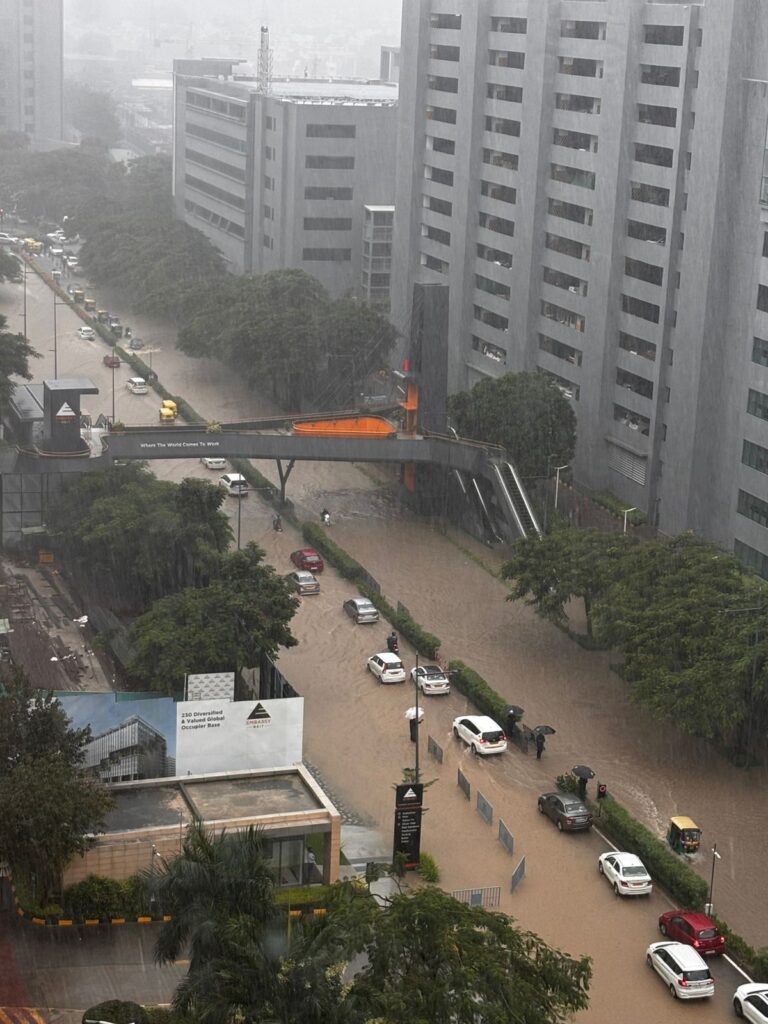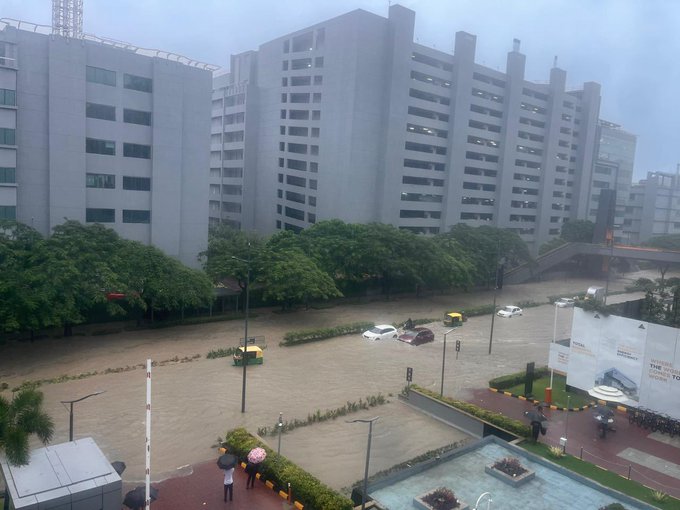Bengaluru, India’s IT hub, is once again in the grip of severe weather as relentless rains have caused widespread flooding and disruption throughout the city. Manyata Tech Park, one of the largest office complexes in Bengaluru, has been particularly hard-hit, with waterlogging transforming the sprawling 300-acre campus into a near-lake. The flooding has led to traffic gridlocks, temporary closures, and work-from-home advisories for many businesses. The situation has sparked concerns over the city’s infrastructure and its capacity to handle extreme weather events.


The Onset of Flooding in Bengaluru
The current weather crisis began with continuous rainfall starting in mid-October 2024, leaving much of Bengaluru submerged. The city recorded 66.1 mm of rainfall in just 24 hours on Wednesday, with the India Meteorological Department (IMD) issuing an orange alert, predicting more heavy rainfall in the coming days. This relentless downpour has disrupted daily life in key areas such as Bellandur, Whitefield, HSR Layout, and Koramangala.
While flooding in these regions is not new during monsoon seasons, the extent and intensity of this year’s rainfall have taken many by surprise. The city has experienced 228% excess rainfall compared to its usual single-day average, leading to large-scale waterlogging and disruption of essential services.
Manyata Tech Park: Flooding and Wall Collapse
One of the most affected areas is Manyata Tech Park, located in Nagawara along the Outer Ring Road. The tech park, home to several Fortune 500 companies, was submerged under water after a retaining wall collapsed near Gate No. 2 on October 15. The collapse occurred close to an ongoing construction site, where the already rain-soaked ground gave way, resulting in a cascade of water flowing through the area. Social media users humorously dubbed the site “Manyata Tech Falls,” but the situation is far from amusing for those stranded in the area.
Impact on Daily Operations
Businesses inside Manyata Tech Park were quick to respond to the flooding. Several companies instructed their employees to stay indoors until the roads cleared, and others shifted operations to remote working. Traffic around the tech park was severely disrupted, with roads leading to and from the campus submerged, making it impossible for vehicles to navigate safely. The flooding extended beyond Manyata Tech Park to other areas like Geddalahalli Railway Underbridge and the RGA Tech Park junction.
A City’s Infrastructure Under Scrutiny
The flooding of Manyata Tech Park and other key locations has once again raised questions about Bengaluru’s infrastructure. Despite being one of India’s fastest-growing cities and a major IT hub, Bengaluru has long struggled with inadequate drainage systems and poor urban planning. The city’s transformation from a landscape of lakes to one of concrete developments has made it particularly vulnerable to flooding during monsoon seasons.
Residents and experts alike have voiced frustration over the city’s inability to handle heavy rains. The fact that areas like Manyata Tech Park are located on or near old lakebeds makes them more susceptible to waterlogging. One social media user pointed out, “It was a lake. Of course, water would flow towards it because that’s the way it has always known.”
Efforts to Address the Situation
In response to the crisis, the Karnataka government has taken several emergency measures. School and college closures have been extended, and the government has issued advisories for IT and biotechnology firms to allow employees to work from home. Revenue Minister Krishna Byre Gowda confirmed the deployment of 60 personnel from the National Disaster Response Force (NDRF) and the Karnataka State Disaster Response Force (SDRF) to assist with evacuation and rescue operations. An additional 40 personnel remain on standby.
Emergency helplines have been set up by the Bruhat Bengaluru Mahanagara Palike (BBMP) to assist commuters and residents impacted by the flooding. These helplines have been critical in responding to incidents such as the evacuation of residents from Kendriya Vihar Apartments in Yelahanka, where flooding was particularly severe.
Weather Forecast and Concerns Ahead
The IMD has forecast more rain for the city over the next few days, with thunderstorms, lightning, and squalls expected in coastal, north interior, and south interior Karnataka until October 18. Overcast skies are predicted to persist, keeping the city on high alert for further waterlogging and disruption.
This season’s rains are considered an anomaly, even by Bengaluru’s weather standards. “Bengaluru received unprecedented rains during this month. Normally there is rain, but not to this magnitude,” commented Karnataka minister G Parameshwara. He added that precautionary measures had been put in place to prevent what could have been an even more severe situation.
The Bigger Picture: Long-Term Solutions Needed
The flooding and infrastructure collapse in Manyata Tech Park and other areas point to a larger issue—the need for comprehensive urban planning and improved infrastructure to handle extreme weather. Bengaluru’s rapid urbanization has resulted in the destruction of natural waterways and lakes that once acted as natural drainage systems. Without significant investment in upgrading the city’s drainage systems and improving flood management strategies, similar crises are likely to recur.
The Karnataka government, alongside urban planners and environmentalists, will need to address these long-standing issues to prevent future disasters. This will likely involve a combination of restoring old water bodies, enforcing stricter building regulations, and implementing better rainwater harvesting techniques.
Conclusion
The recent flooding of Manyata Tech Park is a stark reminder of Bengaluru’s ongoing struggle with extreme weather and inadequate infrastructure. As the city battles the consequences of urbanization and poor drainage systems, residents and businesses are left to contend with the disruptive effects of heavy rainfall. The need for long-term solutions to these issues is more pressing than ever as Bengaluru’s status as a global IT hub hangs in the balance, threatened by increasingly severe monsoon seasons.
| Specification | Details |
|---|---|
| Location | Manyata Tech Park, Nagawara, Outer Ring Road, Bengaluru |
| Affected Areas | Bellandur, Whitefield, HSR Layout, Koramangala, Manyata Tech Park |
| Weather Condition | Heavy rainfall (66.1 mm in 24 hours), thunderstorms expected |
| Key Incidents | Retaining wall collapse, waterlogging, traffic disruption |
| Emergency Measures | NDRF, SDRF deployed, school closures, work-from-home advisories |
| Weather Forecast | Continued heavy rainfall until October 18 |
| Government Response | Flood management, drainage improvements, emergency helplines set up |
As the situation evolves, Bengaluru must rethink its urban development strategies and prioritize sustainable infrastructure solutions to safeguard against future flooding events.


